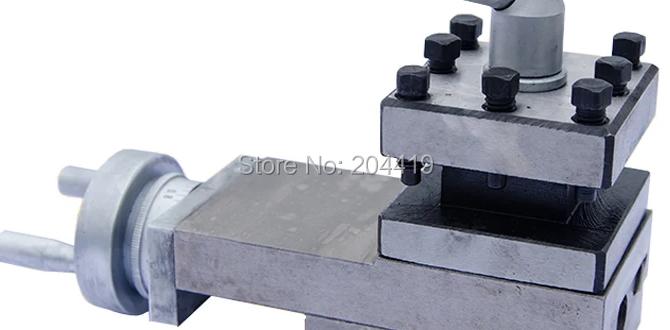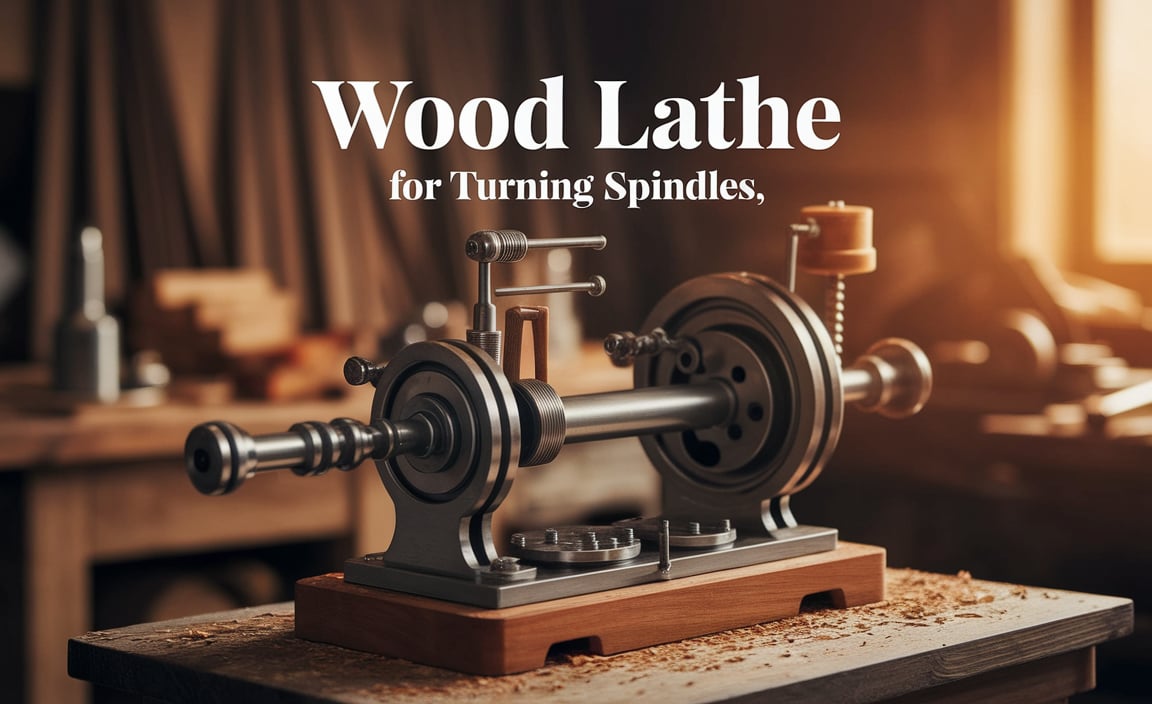Quick Summary:
A TiALN ball nose end mill, especially one with suitable flute angles for tool steel, is crucial for complex shaping and plunge milling in hardened materials like A2 steel. Its advanced coating resists heat and wear, allowing for deeper cuts and better surface finishes, making it indispensable for intricate tool and die work.
Hey there, fellow makers! Daniel Bates here from Lathe Hub. Ever stared at a piece of tough tool steel, like A2, and wondered how to carve those smooth, rounded contours or plunge deep into its hard surface without breaking your tool? It’s a common puzzle for beginners (and even experienced folks!) when tackling intricate projects. The secret often lies in having the right cutting tool for the job. Today, we’re diving into a real workhorse: the TiALN ball nose end mill. Get ready to understand why this specific tool is a game-changer for working with challenging materials.
Why Tool Steel is a Machining Challenge
Tool steel is designed for toughness, durability, and holding an edge, which makes it fantastic for… well, making tools! But this also means it’s incredibly hard and resistant to abrasion. When you try to machine it with standard end mills, you’ll often run into problems like:
- Rapid tool wear and chipping
- Excessive heat buildup
- Poor surface finish
- Difficulty in achieving complex shapes
- Risk of tool breakage
Traditional end mills just can’t stand up to the demands of profiling, slotting, or plunging into hardened tool steels without some serious drawbacks. This is where specialized tooling comes into play.
Introducing the TiALN Ball Nose End Mill
So, what makes a TiALN ball nose end mill so special, especially when you’re dealing with something like A2 tool steel? Let’s break it down:
The “Ball Nose” Advantage
A ball nose end mill, as the name suggests, has a rounded, hemispherical cutting tip. This shape is incredibly versatile. Unlike flat-bottomed end mills, a ball nose end mill can:
- Create smooth, contoured surfaces (like fillets and rounded valleys).
- Mill complex 3D shapes and organic forms.
- Perform “swarf cutting,” where the side of the ball is used for a smooth finish.
- Leave a desirable radius at the bottom of pockets, reducing stress concentrations
This rounded tip is a lifesaver when you’re aiming for precision curves and shapes that a flat end mill simply can’t achieve without leaving a sharp corner.
The Power of TiALN Coating
Now, let’s talk about the coating: TiALN. This stands for Titanium Aluminum Nitride. It’s a multi-layered coating applied to the surface of the cutting tool, and it’s a game-changer for machining tough materials like tool steel.
- Heat Resistance: TiALN coatings are incredibly effective at withstanding high temperatures. When machining tough metals, friction generates a lot of heat. This coating acts as a heat shield, preventing the cutting edge from softening and dulling prematurely. This is absolutely critical for tool steels, which generate significant heat during cutting.
- Wear Resistance: The ceramic-like nature of TiALN provides excellent resistance to abrasive wear. This means the cutting edge stays sharp for much longer, leading to more consistent cuts and a better surface finish on your workpiece.
- Lubricity: While not as “slippery” as some other coatings, TiALN does offer some reduction in friction, helping chips flow more freely.
- Oxidation Resistance: TiALN maintains its integrity at higher temperatures than coatings like TiN (Titanium Nitride), making it ideal for high-speed machining and tougher materials.
For machining hardened tool steels, especially at higher speeds, a TiALN coating is almost a necessity. It allows the end mill to perform under stresses and temperatures that would quickly destroy an uncoated or less robustly coated tool.
Why a 35-Degree Helix Angle Matters for Tool Steel
When you see specifications like “35-degree helix angle” on a ball nose end mill for tool steel, don’t let it intimidate you. This refers to the angle of the flutes (the spiral grooves that flute the chips away). For many applications, especially with softer metals, you might see helix angles of 45 degrees or even higher. However, for hardened tool steels like A2, a lower helix angle often brings significant benefits:
- Increased Strength: A lower helix angle means more cutting edge engagement and a stronger cutting edge. This reduces the risk of chipping, especially when plunging or taking heavier cuts.
- Smoother Cutting Action: A lower helix angle can result in a slightly more aggressive cut, but it also helps to break chips into smaller, more manageable pieces. This is crucial in tool steel where long, stringy chips can cause problems.
- Plunge Milling Capabilities: When you need to “plunge” an end mill directly down into the material (like drilling a hole or starting a pocket), a lower helix angle provides more resistance to the axial cutting forces. This makes plunge milling more stable and less likely to cause tool deflection or breakage.
While higher helix angles are great for achieving smoother surface finishes and better chip evacuation in softer materials, the robustness and stability offered by a 35-degree helix angle make it a preferred choice for the rigors of machining hardened tool steels.
Key Features to Look for in a TiALN Ball Nose End Mill for Tool Steel
When you’re out shopping for the right tool, keep these essential features in mind to make sure you’re getting the best bang for your buck and the best performance for your project:
- Material Grade Suitability: Ensure the end mill is specifically recommended for hardened steels (like tool steels, stainless steels, etc.).
- Number of Flutes: For tool steel, you’ll often see 2-flute or 4-flute end mills.
- 2-Flute: Generally better for aggressive plunging and slotting, and can handle tougher materials. They offer more chip clearance.
- 4-Flute: Provide a smoother finish and can handle higher feed rates once you’re profiling. They are generally more versatile but might struggle slightly more with deep plunge cuts in very hard materials compared to a 2-flute.
For general-purpose milling in tool steel, especially with plunge capabilities, a 2-flute is often a solid starting point.
- Tolerance and Runout: Look for tools with tight tolerances and low runout (wobble). This ensures accuracy and longevity. Reputable manufacturers will specify these.
- Core Diameter vs. Neck Relief: For deeper cavities, a tool with a reduced neck diameter behind the cutting head is essential. This prevents the body of the end mill from rubbing against the walls of the workpiece, allowing for deeper cuts and better accessibility.
- Manufacture Quality: Brand reputation matters! Invest in tools from well-established manufacturers known for their quality control and materials.
Practical Applications: When You NEED This Tool
So, where does this specialized tool really shine? Here are some scenarios where a TiALN ball nose end mill becomes your best friend:
- Die Making: Carving out precise cavities and contours in dies for stamping, forging, or injection molding.
- Mold Making: Creating intricate patterns and shapes in molds for plastics or other materials.
- Prototyping Complex Parts: When you need to develop a part with rounded features or deep cavities in a strong material.
- Engraving Hardened Parts: For creating precise, durable engraved marks on tool steel components.
- Aerospace and Medical Components: Machining high-strength alloys where precision and finish are paramount.
- Custom Fixturing: Building specialized jigs and fixtures from hardened materials.
Essentially, any project where you need to create smooth, radiused shapes or plunge into hardened steel is a prime candidate for this type of end mill.
How to Use Your TiALN Ball Nose End Mill Safely and Effectively
Using any cutting tool requires care, but with specialized tools like these, understanding best practices ensures you get the most out of your investment and stay safe.
Preparation is Key
Before you even think about pressing “start,” make sure you have:
- Secure Workholding: Your workpiece MUST be clamped down extremely securely. Tool steel is tough – if it moves, it’s dangerous. Use a robust vise or other appropriate workholding.
- Rigid Machine Setup: Ensure your milling machine is in good working order, with no excessive play in the spindle or axes.
- Coolant/Lubrication: While TiALN helps with heat, using a good quality coolant or cutting fluid is still highly recommended. It cools the cutting zone, washes away chips, and extends tool life. For tool steels, a flood coolant system is often preferred.
- Correct Speeds and Feeds: This is CRITICAL. Tool steels require different speeds and feeds than softer metals.
Speeds and Feeds: The Balancing Act
Finding the “perfect” speeds and feeds can feel like alchemy, but here’s a general approach for TiALN ball nose end mills on A2 tool steel (remember, always start conservatively and adjust)
General Guidelines for A2 Tool Steel (Hardened to ~58-60 HRC) with a TiALN Ball Nose End Mill:
| Operation | Spindle Speed (SFM) | Feed Rate (IPM) | Depth of Cut (DOC – Axial) | Depth of Cut (DOC – Radial) | Notes |
|---|---|---|---|---|---|
| Plunge Milling (Vertical) | 50-100 SFM (approx. 400-800 RPM for 1/4″ tool) | 0.001 – 0.002 IPM per flute | 0.05 – 0.1 x Tool Diameter | N/A | Use 2-flute for best plunge. Low feed, slow plunge. |
| Slotting/Pocketing (2D) | 75-150 SFM (approx. 600-1200 RPM for 1/4″ tool) | 0.002 – 0.004 IPM per flute | 0.1 – 0.25 x Tool Diameter | 0.1 x Tool Diameter (Slotting) | Good chip evacuation is key. |
| 3D Contouring/Profiling | 100-200 SFM (approx. 800-1600 RPM for 1/4″ tool) | 0.003 – 0.006 IPM per flute | 0.02 – 0.05 x Tool Diameter (Steep areas) | 0.05 – 0.2 x Tool Diameter (Swarf/Curved areas) | Smaller stepovers yield better surface finish. |
Important Notes on the Table:
- These are starting points! Always consult your end mill manufacturer’s recommendations if available.
- SFM = Surface Feet per Minute. IPM = Inches per Minute.
- RPM calculation for end mills: RPM = (SFM * 3.82) / Tool Diameter (in inches).
- Start conservatively. If you hear chattering, see excessive heat, or the tool is struggling, reduce speed and/or feed.
- For plunge milling, the feed rate is critical for tool life and stability.
- Radial Depth of Cut (stepover) significantly impacts surface finish in 3D contouring. Smaller stepovers create smoother surfaces.
For more detailed information on calculating speeds and feeds, resources like the South Bend Lathe Speeds and Feeds Calculator can be very helpful.
Machining Techniques
Plunge Milling: When plunging, use a slow, controlled feed rate. It’s not like drilling; the end mill is cutting on its side as it descends. A 2-flute end mill is generally preferred for better chip clearance when plunging vertically.
Slotting and Pockets: Ensure your coolant is directed effectively to clear chips. If chips are not evacuating well, you may need to slightly increase your feed rate (causing chips to break) or use a chip-blasting coolant nozzle, or pecking cycles (like drilling), though full peck cycles aren’t always ideal for end mills. Sometimes, stepping out of the pocket briefly to clear chips is best.
3D Contouring: Use small stepovers (radial depth of cut) for a smooth surface finish. The TiALN coating and ball nose shape excel here, but take advantage of it by optimizing your toolpath settings.
Tool Maintenance and Inspection
Cleanliness: After each use, clean your end mill thoroughly. Remove any residual chips or coolant build-up, which can be corrosive over time.
Inspection: Regularly inspect the cutting edges for any signs of chipping, wear, or dulling. A dull tool is a dangerous tool that requires more force and generates more heat.
Storage: Store your end mills in a protective case or holder to prevent damage to the cutting edges and coating.
Comparing TiALN Ball Nose to Other Options
It’s always good to know why you’re choosing one tool over another. Here’s a quick comparison:
| End Mill Type | Best For | Pros | Cons |
|---|---|---|---|
| Uncoated Carbide Ball Nose | Softer steels, aluminum, plastics | Cost-effective, good for general use in softer materials | Poor heat resistance, rapid wear in tool steel, requires slower speeds. |
| TiN Coated Ball Nose | Mild steels, aluminum alloys | Better wear resistance than uncoated, good lubricity | Lower heat resistance than TiALN, will struggle in hardened tool steels. |
| Advanced Coatings (ZrN, AlCrN, etc.) | Specific exotic alloys, high-temp materials | Excellent heat and wear resistance for specialized tasks | Can be more expensive, may require very specific machining parameters. |
| TiALN Coated Ball Nose | Hardened tool steels, stainless steels, high-temp alloys | Excellent heat and wear resistance for demanding applications, good for plunge milling | Can be slightly more brittle than some other coatings under continuous impact; requires proper speeds/feeds. |
“Carbide” is the base material of the tool itself, chosen for its hardness and heat resistance. The “coating” (like TiALN) is applied on top of that to further enhance its performance, especially at higher temperatures and with tougher materials.
Where to Learn More About Machining
To truly master machining and the use of tools like these, continuous learning is key. Don’t hesitate to seek out more information:
- Manufacturer Websites: Major tool manufacturers (like Sandvik Coromant, Iscar, Kennametal, Guhring) often have extensive technical datasheets and application guides.
- Machining Forums and Online Communities: Places like practicalmachinist.com or hobbyist machining forums are full of experienced people sharing tips.
- YouTube Channels: Many skilled machinists and educators provide visual demonstrations and detailed explanations.
- Your Local Machine Shop: If you have the opportunity, talking to professionals in the field can provide invaluable real-world advice.
- For some excellent foundational knowledge, check out resources from organizations like the National Institute of Standards and Technology (NIST) on advanced manufacturing topics.
Frequently Asked Questions (FAQ)
Q1: What is the main benefit of using a ball nose end mill instead of a flat end mill on tool steel?
A1: A ball nose end mill has a rounded tip, allowing you to create smooth, curved surfaces, fillets, and contours. A flat end mill can only create sharp 90-degree corners or flat bottoms, making it unsuitable for many complex shapes.
Q2: Can I use a TiALN ball nose end mill on softer metals like aluminum?
A2: Yes, you can, but it might be overkill. TiALN coatings are designed for high-temperature applications, and softer metals don’t generate as much heat. You might find





